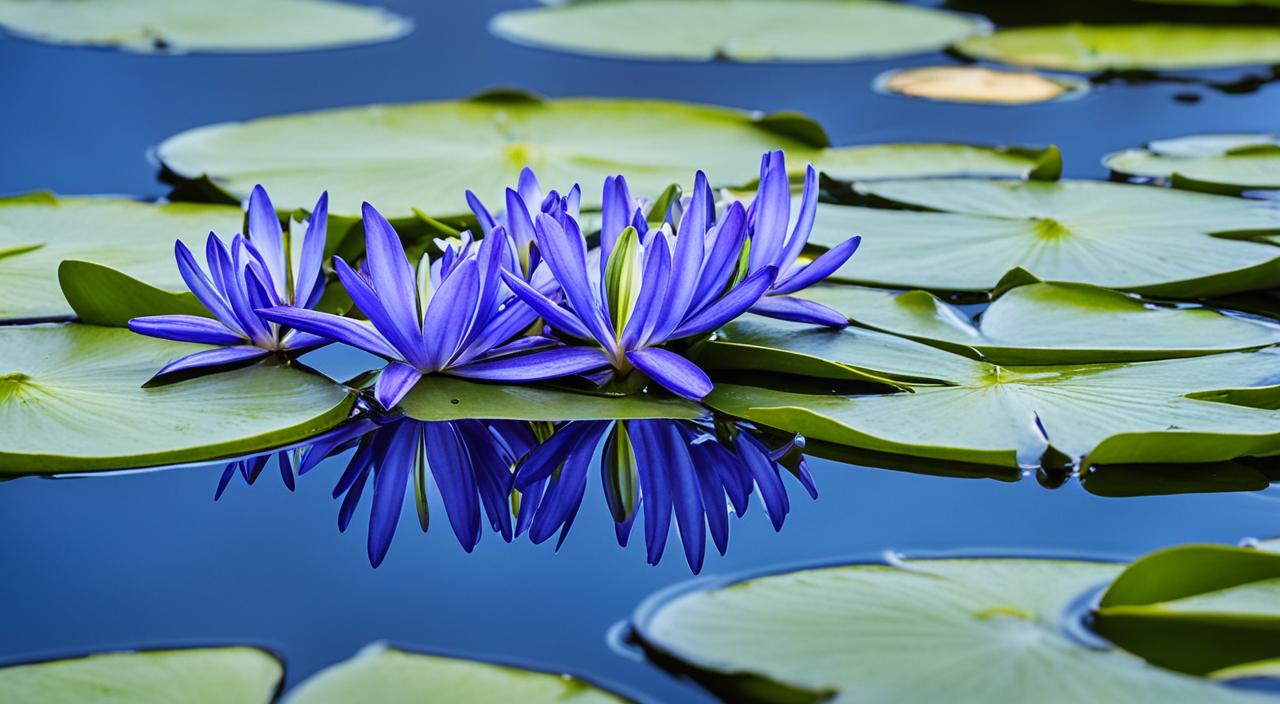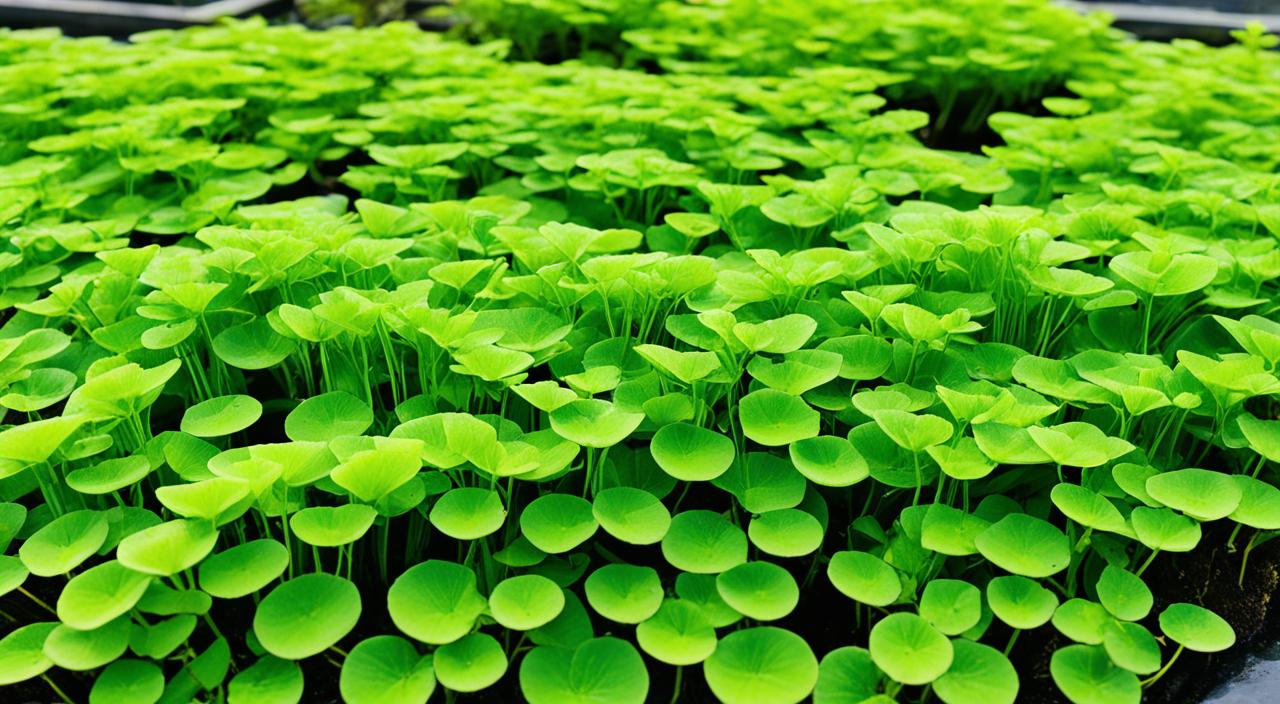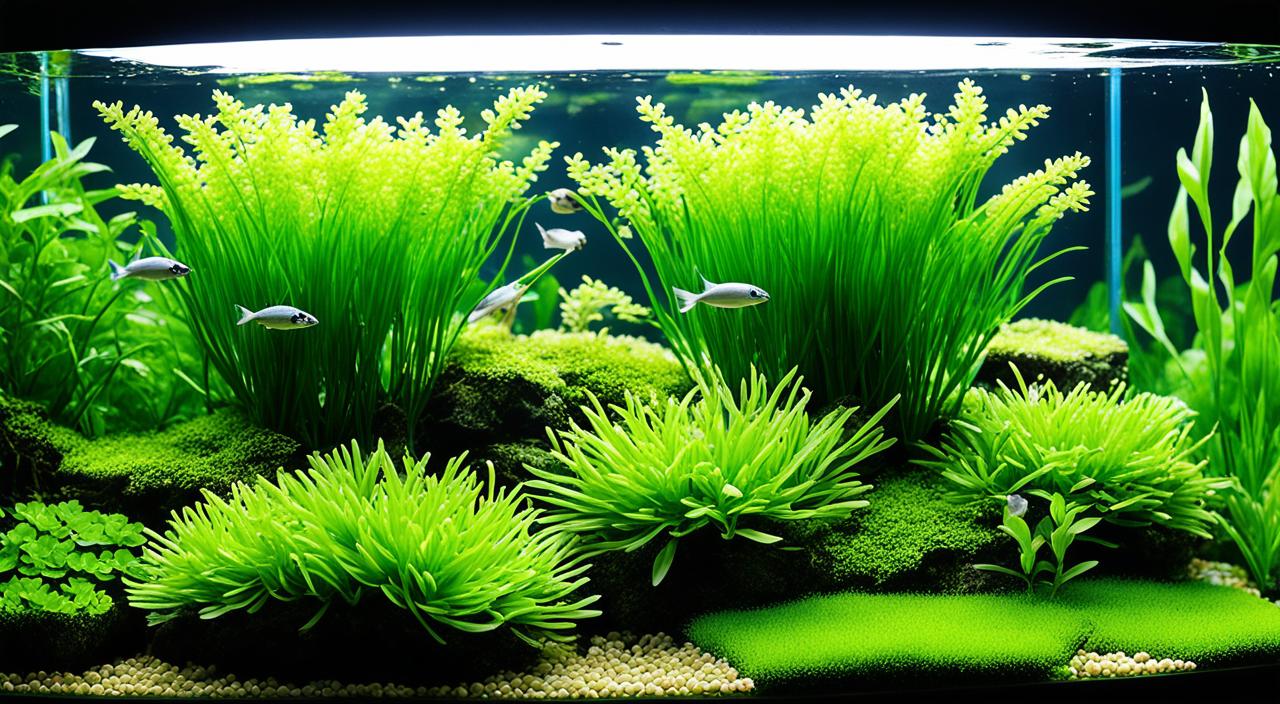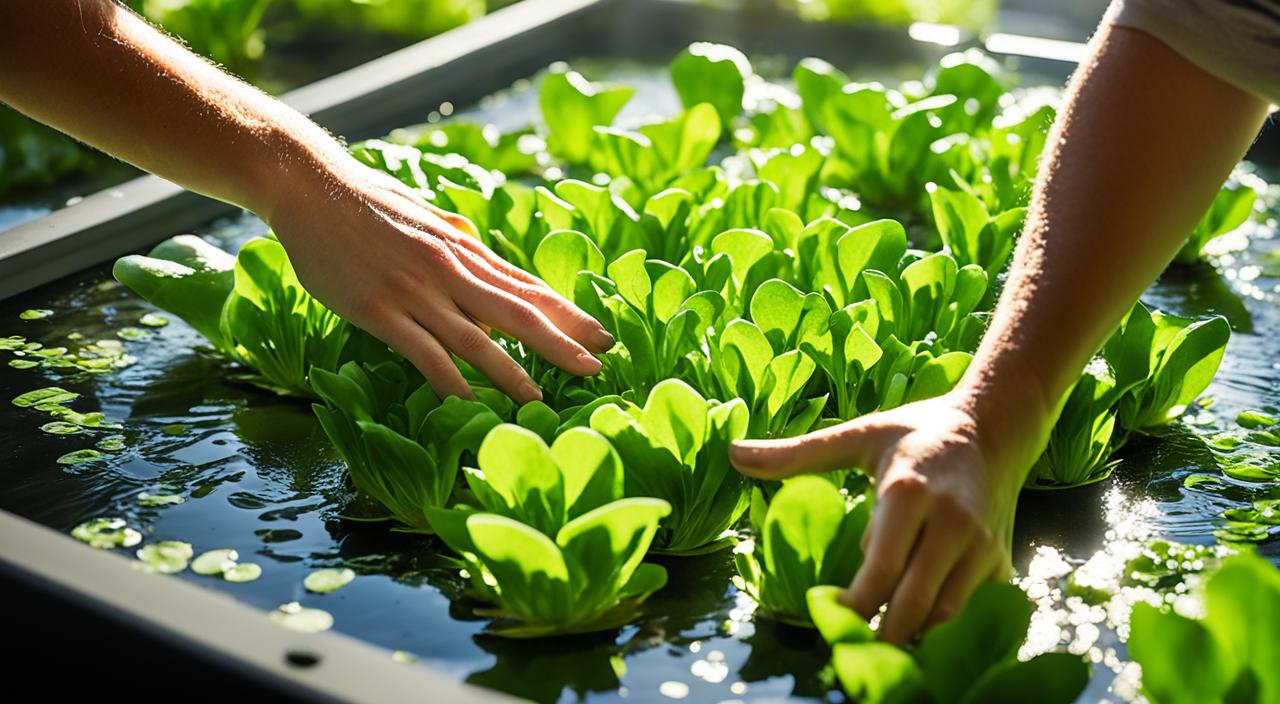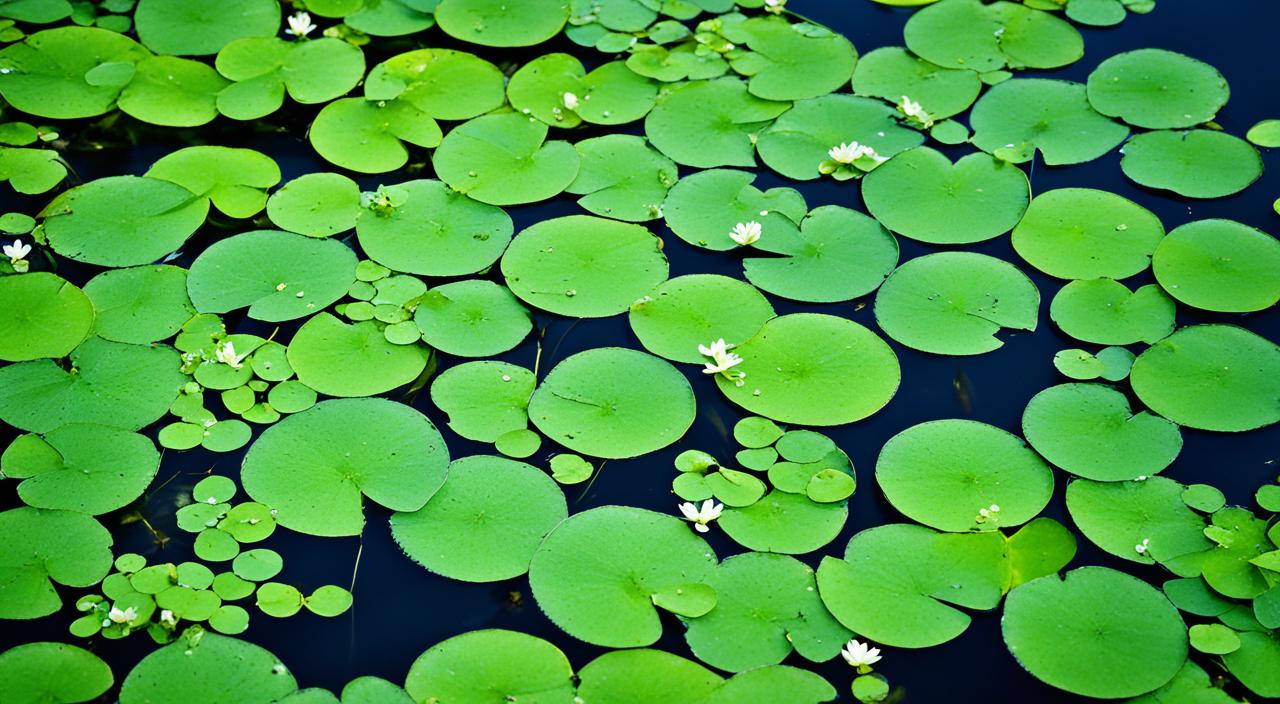G’day mates! Today, I will dive into the fascinating world of water hyacinth, also known as Eichhornia crassipes. This aquatic plant, native to South America, has made quite a name for itself worldwide. While it may appear beautiful and harmless, water hyacinth is an invasive species that can wreak havoc on aquatic ecosystems if left unchecked.
Water hyacinth has a knack for rapid growth, forming dense mats that block waterways, hinder sunlight penetration, and disrupt the natural balance of our ponds and lakes. It’s a tough little plant that can outcompete native species and lead to a decline in biodiversity.
But fear not, my fellow aquarists and pond enthusiasts! There are effective management strategies that can help control the growth of water hyacinth and mitigate its ecological impact. From proper placement and lighting to feeding and maintenance, we’ll explore all the ins and outs of caring for this aquatic troublemaker.
Key Takeaways:
- Water hyacinth, or Eichhornia crassipes, is an invasive aquatic plant.
- It proliferates and forms dense mats that disrupt ecosystems and degrade water quality.
- Effective management strategies are necessary to control its growth and mitigate its impact.
- Proper placement, lighting, feeding, and maintenance are vital for water hyacinths.
- By following appropriate care practices, we can enjoy the beauty of this plant without compromising the health of our aquatic environments.
Brief Overview Of Water Hyacinth (Eichhornia crassipes)
Water hyacinth (Eichhornia crassipes) is a free-floating aquatic plant that thrives in freshwater environments. It features long, spongy roots and roundish, glossy green leaves that form rosettes. Above the rosette, the water hyacinth produces showy lavender-blue flowers arranged in spikes. This plant is known for its rapid growth and ability to reproduce quickly through stolons or “daughter” plants.
While water hyacinths’ growth potential is impressive, they can also have detrimental ecological impacts. Its aggressive nature leads to the formation of dense mats that disrupt native ecosystems and impact water quality. These mats block sunlight, degrade water quality, and displace native plant communities. Effective management strategies are essential to prevent the spread of water hyacinths and protect the natural balance of aquatic habitats.
Origins And Habitat
Water hyacinth is native to South America, where it grows naturally in a variety of freshwater environments. It was introduced to other parts of the world as an ornamental plant and has since become naturalized in many regions. Water hyacinths can be found in lakes, ponds, rivers, and wetlands, thriving in warm climates with nutrient-rich waters. It is particularly invasive in tropical and subtropical regions, where it forms dense mats that can dominate aquatic ecosystems. Effective management measures are necessary to prevent the spread of water hyacinths and protect native plant communities.
Morphological Characteristics
Water hyacinth, scientifically known as Eichhornia crassipes, is a perennial aquatic plant with unique morphological characteristics. Understanding its plant structure and morphology is essential for proper identification and effective management.
The plant possesses long, dark roots that serve as anchors, providing stability and enabling access to nutrients from the surrounding water. These roots are crucial in supporting the plant’s growth and survival.
Water hyacinth leaves are roundish or broadly elliptic and have a glossy green appearance. They can grow up to 15 cm in width, providing an ample surface area for photosynthesis and nutrient absorption.
The leaves are attached to spongy and sometimes inflated stalks, which help the plant stay afloat and maintain its position on the water’s surface. This unique adaptation allows water hyacinths to thrive in freshwater environments.
One of the standout features of water hyacinth is its showy lavender-blue flowers. The flowers are arranged in spikes above the rosette and have approximately 5 cm wide petals. Each flower has six petals and six stamens, adding a vibrant touch to the plant’s overall appearance.
Water hyacinth also produces ovoid ribbed capsules that contain up to 50 seeds. These capsules are responsible for the plant’s reproductive cycle, enabling it to propagate and spread its presence in aquatic ecosystems.
Understanding the morphological characteristics of water hyacinth, including its plant structure, leaves, flowers, and reproductive mechanisms, is crucial for its identification and effective management. By recognizing and studying these unique traits, we can better appreciate the beauty and adaptability of this aquatic plant species.
Placement And Lighting
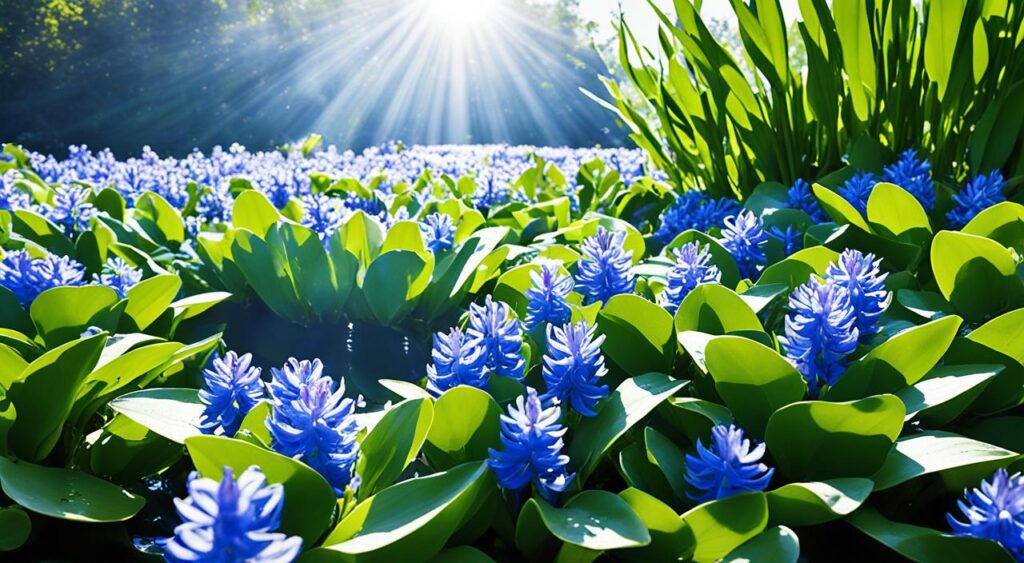
Water hyacinth requires bright light to thrive and grow properly. It should be placed in a well-lit area of the aquarium or pond, preferably with direct sunlight exposure. Adequate lighting is essential for photosynthesis, which is crucial for the plant’s growth and nutrient absorption. However, excessive light can lead to algae overgrowth and disrupt the balance of the ecosystem. It is vital to strike a balance and provide the appropriate light for water hyacinth.
What Are Good Tank Mates?
Water hyacinths can coexist harmoniously with various fish species in aquariums or ponds. It is crucial to select compatible tank mates that will not uproot or damage the plant and can thrive alongside water hyacinth. Ideally, opt for small herbivorous fish species that complement the aquatic plant without causing any harm. Some suitable fish species that can be considered as good tank mates for water hyacinths include:
- Guppies
- Swordtails
- Mollies
- Certain species of tetras
These fish species have a gentle temperament, are relatively small, and typically do not feed on or disturb the water hyacinth plant. They are also compatible with water hyacinths’ light and water requirements, making them suitable companions in an aquatic environment.
Fish Species to Avoid
While choosing tank mates for water hyacinths, it is essential to avoid certain fish species that may uproot the plant or nibble on its leaves, causing damage. Additionally, aggressive or large fish species should be avoided to prevent them from damaging or displacing water hyacinths. Some fish species that should be avoided as tank mates for water hyacinth include:
- Arowanas
- Cichlids (such as Oscars or Flowerhorns)
- Goldfish (particularly more significant varieties)
- Plecos (common plecos can grow large and uproot plants)
These fish species can disrupt water hyacinths’ growth and stability, making them unsuitable companions in an aquarium or pond.
Feeding (Fertilization)
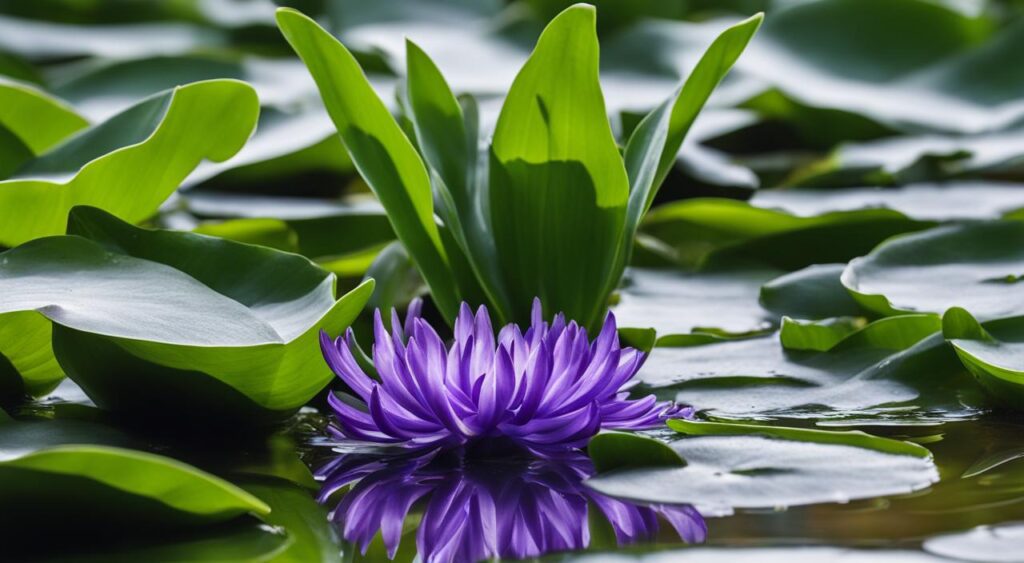
Water hyacinth is a nutrient-demanding plant that relies on the water column for its nutrient supply. It can extract nutrients from the surrounding water, making it an effective natural filter for aquariums and ponds. However, supplementing the plant’s nutrient requirements through fertilization can promote its growth and overall health.
Water hyacinths can be fed with liquid fertilizers formulated explicitly for aquatic plants or with organic Matter such as fish waste or compost. Liquid fertilizers provide a convenient and controlled way to deliver essential nutrients to the plant. Organic Matter, on the other hand, not only provides nutrients but also contributes to the overall health of the aquatic ecosystem.
The frequency and amount of feeding will depend on the nutrient levels in the water and the plant’s growth rate. Regular monitoring of nutrient levels and observing the plant’s growth can help determine the appropriate feeding schedule. It is essential to balance providing enough nutrients for the plant’s growth and avoiding nutrient imbalances or excesses that can lead to algae overgrowth and water quality issues.
| Feeding Method | Benefits |
|---|---|
| Liquid Fertilizers | Convenient and controlled nutrient delivery |
| Organic Matter (e.g., fish waste, compost) | Contributes to the overall health of the aquatic ecosystem |
CO2 Injection
Carbon dioxide (CO2) is an essential nutrient for the growth and development of aquatic plants, including water hyacinths. Injecting CO2 into the aquarium or pond can promote water hyacinth growth and overall health.
Types
Different methods and systems are available for CO2 injection, each with advantages and considerations. The choice of CO2 injection method will depend on the specific needs and setup of the aquarium or pond.
1. Compressed CO2 Gas Systems: These systems involve using a pressurized CO2 cylinder and a regulator to control the flow of CO2 into the water. This method provides precise control over CO2 levels and is suitable for larger setups or aquariums with high demands for CO2.
2. DIY Yeast-Based CO2 Systems: This method involves creating a homemade setup using yeast, sugar, and water. The yeast ferments the sugar, producing CO2 as a byproduct. This CO2 is then released into the aquarium through a diffuser or airstone. While DIY yeast-based CO2 systems are more affordable, they may not provide as consistent or high levels of CO2 as compressed gas systems.
3. Liquid Carbon Supplements: Liquid carbon supplements, such as glutaraldehyde-based products, can be added directly to the water to provide a plant carbon source. These supplements are easy to use and suitable for smaller aquariums or setups with lower CO2 demands. However, it is essential to carefully follow the dosage instructions, as high concentrations of liquid carbon can harm fish and invertebrates.
Providing adequate CO2 supplementation can enhance the growth and vibrancy of water hyacinth, contributing to its overall care and well-being.
Care
Planted Tank Parameters
To ensure the health and vitality of water hyacinth in a planted tank or pond, it is essential to maintain appropriate parameters that support its growth. This includes providing suitable water quality with stable temperature, pH, and hardness levels. The ideal temperature range for water hyacinth is between 70°F and 80°F (21°C and 27°C), and the pH should be maintained between 6.5 and 7.5. Hardness levels should be kept within the range of 3 to 8 dKH.
Water Quality
Water quality plays a crucial role in the well-being of water hyacinths. It is essential to regularly monitor and maintain optimal water conditions to ensure the plant’s health. This includes regular water testing to check parameters such as ammonia, nitrite, nitrate levels, and overall water hardness. Proper water quality management involves maintaining appropriate nutrient levels while minimizing the accumulation of excess nutrients that can lead to algae growth.
Filtration
Filtration systems are essential for maintaining water clarity and removing impurities that can negatively impact water quality. A sound filtration system should include mechanical, chemical, and biological components. Mechanical filtration removes debris and particulate Matter, while chemical filtration helps remove dissolved impurities. Biological filtration promotes the growth of beneficial bacteria that help break down harmful substances and keep the water clean. Regular maintenance of the filtration system, including regular cleaning and replacing filter media, is crucial in ensuring its effectiveness.
Flow
Adequate water flow is essential for water hyacinths’ overall health and well-being. It helps distribute nutrients evenly throughout the tank, preventing water from becoming stagnant. A gentle yet steady flow is ideal for water hyacinths, as excessive water movement can cause damage to the delicate leaves and roots. The flow can be achieved through a circulation pump or strategically placed water outlets.
| Parameter | Ideal Range |
|---|---|
| Temperature | 70°F – 80°F (21°C – 27°C) |
| pH | 6.5 – 7.5 |
| Hardness | 3 – 8 dKH |
Aquarium Maintenance
Regular maintenance is critical to successfully cultivating water hyacinths in an aquarium. This involves testing water conditions regularly to ensure optimal growth and health of the plants. Monitoring parameters such as temperature, pH, ammonia, nitrite, and nitrate levels is essential for maintaining suitable water quality.
Testing Water Conditions
To maintain a healthy aquatic environment for water hyacinths, it is crucial to test the water conditions regularly. This includes monitoring the temperature, pH, ammonia, nitrite, and nitrate levels. Testing kits are readily available and can provide accurate and timely information about the water quality in your aquarium. By understanding and maintaining proper water conditions, you can ensure water hyacinth’s optimal growth and development.
How To Set Up Your Aquarium Tank
Properly setting up your aquarium tank is vital for successfully cultivating water hyacinths. Here are some critical steps to follow:
- Substrate: Choose a suitable substrate for your aquarium tank, such as gravel or aquatic soil, to provide a nutrient-rich base for the plants to thrive.
- Lighting: Provide adequate lighting for water hyacinth, as it requires bright light to carry out photosynthesis effectively. LED lights with a spectrum suitable for plant growth are recommended.
- Filtration: Install a filtration system to maintain water clarity and remove excess nutrients that can lead to algae growth. Combining mechanical, biological, and chemical filtration can help create a balanced and healthy environment.
- Water Flow: Ensure proper water flow in the tank to distribute nutrients evenly and prevent stagnation. Consider using a water pump or creating water movement using airstones or powerheads.
Propagation Methods
Water hyacinth can be propagated through different methods to expand its population in the aquarium. Here are two standard propagation methods:
- Dividing Daughter Plants: As water hyacinth reproduces rapidly through stolons or “daughter” plants, you can separate these new plants from the parent plant and transfer them to other aquarium areas.
- Growing from Seeds: Another propagation method is collecting and germinating water hyacinth seeds. This method requires proper preparation and set conditions to ensure successful seed germination.
By following appropriate aquarium maintenance practices, including regular water testing, correct tank setup, and utilizing propagation methods, you can create an environment where water hyacinths will thrive and contribute to the beauty and health of your aquarium.
Health And Disease
Maintaining the health of water hyacinth is crucial for its longevity and overall appearance. The signs of good health in water hyacinths include vibrant green leaves, ample growth, and flowers. These indicators demonstrate that the plant is receiving adequate nutrients and is thriving in its environment.
However, there are also signs of poor health that may be observed in water hyacinths. These signs include yellowing or wilting leaves, stunted growth, or the absence of flowers. These symptoms may indicate nutrient deficiencies, imbalances in water quality, or even infections.
To ensure the health and vitality of water hyacinth, it is vital to address any potential health issues promptly. Common health issues affecting water hyacinth include nutrient deficiencies, water quality imbalances, and infections. Treatment methods will depend on the specific problem but may involve adjusting nutrient levels, improving water quality, and implementing pest control measures.
Common Health Issues And Treatment
Some common health issues that can affect water hyacinth include:
- Nutrient deficiencies: If the plant is not receiving sufficient nutrients, it may exhibit stunted growth and yellowing leaves. Supplementing the water with appropriate fertilizers can help address this issue.
- Water quality imbalances: Poor water quality, such as high ammonia or nitrate levels, can negatively impact water hyacinth. Regular water testing and maintaining proper filtration can help improve water quality and prevent stress on the plant.
- Infections: Water hyacinths can be susceptible to various diseases caused by bacteria, fungi, or viruses. If signs of infection, such as discolouration or rotting, are present, it is essential to identify the specific pathogen and treat it accordingly.
Regular monitoring and intervention are crucial to maintaining the health and vitality of water hyacinths. Water hyacinths can thrive and contribute to a beautiful aquatic environment by addressing health issues promptly and providing the necessary care.
Plant Pests
Water hyacinths may also face challenges from pests that can damage their leaves, roots, or overall structure. Common plant pests that can affect water hyacinths include:
- Snails: Snails can feed on water hyacinth leaves, causing damage and inhibiting growth. Manual removal or the introduction of natural predators can help control snail populations.
- Insects: Various insects, such as aphids or caterpillars, may also feed on water hyacinths and cause damage. Insecticidal soaps or biological controls can be used to manage pest infestations.
- Algae: Excessive algae growth can decrease light penetration and negatively impact water hyacinth. Regular water testing and maintenance of appropriate nutrient levels can help prevent algae blooms.
Implementing effective pest management strategies can help protect water hyacinths from damage and maintain their overall health and vigour.
Image
| Signs of Good Health | Signs of Poor Health |
|---|---|
| Vibrant green leaves | Yellowing or wilting leaves |
| Ample growth | Stunted growth |
| Presence of flowers | Absence of flowers |
Summary
Water hyacinth (Eichhornia crassipes) is a perennial free-floating aquatic plant native to South America. It has been introduced to various parts of the world as an ornamental plant but has become a major invasive species in many regions. The plant proliferates and forms dense mats that clog waterways, disrupt ecosystems and degrade water quality.
Effective management strategies are necessary to control the growth of water hyacinth and mitigate its environmental impact. Proper care, including suitable lighting, feeding, and water quality parameters, is essential for cultivating water hyacinths in aquariums or ponds. Following appropriate maintenance practices and monitoring the plant’s health, water hyacinths can thrive and be visually appealing to aquatic environments.
To manage water hyacinth, it is crucial to understand its origins, habitat, and morphological characteristics. The plant is native to South America and thrives in warm climates with nutrient-rich waters. Its long, spongy roots and roundish, glossy green leaves make it easily recognizable. Water hyacinth reproduces quickly through stolons, contributing to its aggressive growth. To prevent the spread of water hyacinths and protect native plant communities, it is necessary to develop effective management strategies and implement them consistently.
FAQ
What is water hyacinth?
Water hyacinth (Eichhornia crassipes) is a perennial free-floating aquatic plant that can form dense mats in waterways.
Where is water hyacinth native to?
Water hyacinth is native to South America.
Why is water hyacinth considered an invasive species?
Water hyacinth is considered an invasive species because it grows rapidly and disrupts native ecosystems.
What are the morphological characteristics of water hyacinth?
Water hyacinth has long roots, roundish glossy green leaves, and showy lavender-blue flowers arranged in spikes.
Where should I place water hyacinth and what lighting does it require?
Water hyacinth should be placed in a well-lit area with direct sunlight exposure to support its growth.
What are suitable tank mates for water hyacinth?
Small herbivorous fish such as guppies, swordtails, and mollies are suitable tank mates for water hyacinth.
How often should I feed water hyacinth?
The feeding frequency will depend on the nutrient levels in the water and the growth rate of the plant. Regular monitoring can help determine the appropriate feeding schedule.
What are the types of CO2 injection for water hyacinth?
There are compressed CO2 gas systems, DIY yeast-based CO2 systems, and liquid carbon supplements available for CO2 injection.
What parameters should I maintain for water hyacinth care?
Suitable water quality parameters include stable temperature, pH, and hardness. Filtration and adequate water flow are also important.
How do I propagate water hyacinth?
Water hyacinth can be propagated by dividing daughter plants or growing from seeds.
What are the signs of good health and poor health in water hyacinth?
Signs of good health include vibrant green leaves, ample growth, and the presence of flowers. Signs of poor health may include yellowing or wilting leaves and stunted growth.
What are the common health issues of water hyacinth and how can they be treated?
Common health issues include nutrient deficiencies, water quality imbalances, and infections. Treatment methods will depend on the specific issue, but may include adjusting nutrient levels, improving water quality, and implementing pest control measures.
What is the summary of water hyacinth care?
Water hyacinth is a free-floating aquatic plant that requires suitable lighting, water quality, and nutrient supplementation. Proper care and monitoring are necessary for its successful cultivation.

